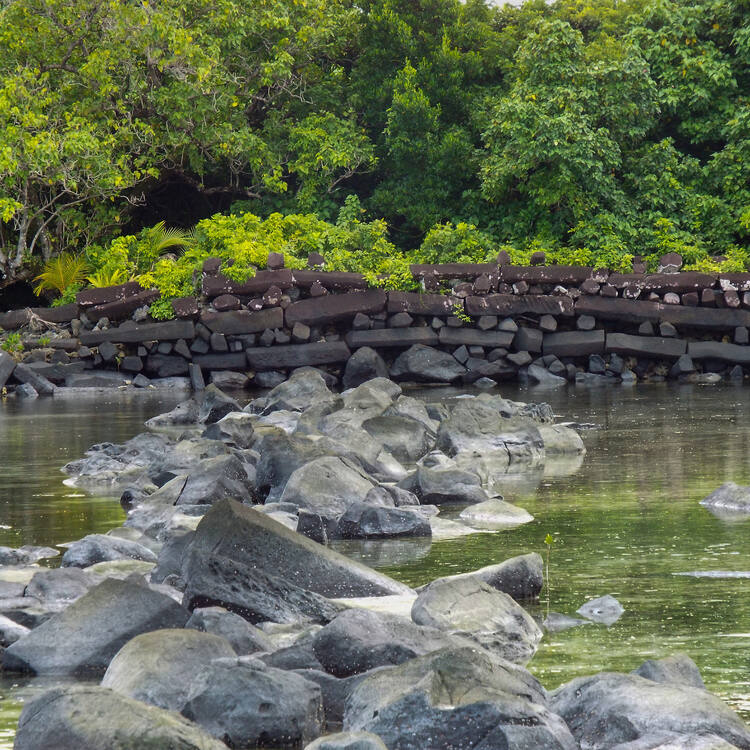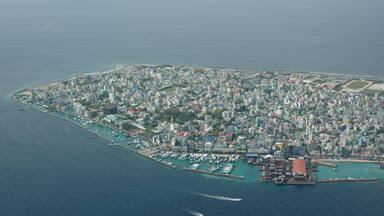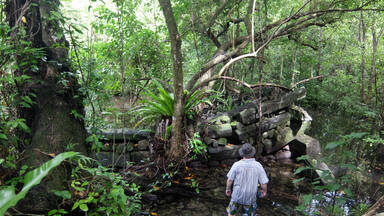Nan Madol: Ceremonial Centre of Eastern Micronesia
Nan Madol: Ceremonial Centre of Eastern Micronesia
Nan Madol is a series of more than 100 islets off the south-east coast of Pohnpei that were constructed with walls of basalt and coral boulders. These islets harbour the remains of stone palaces, temples, tombs and residential domains built between 1200 and 1500 CE. These ruins represent the ceremonial centre of the Saudeleur dynasty, a vibrant period in Pacific Island culture. The huge scale of the edifices, their technical sophistication and the concentration of megalithic structures bear testimony to complex social and religious practices of the island societies of the period. The site was also inscribed on the List of World Heritage in Danger due to threats, notably the siltation of waterways that is contributing to the unchecked growth of mangroves and undermining existing edifices.
Description is available under license CC-BY-SA IGO 3.0
Nan Madol : centre cérémoniel de la Micronésie orientale
Nan Madol est une série de plus de 100 îlots artificiels formés de murs de basalt et de blocs de corail, située au large de la côte sud-est de Pohnpei. Ces îlots abritent les vestiges de palais, de temples, de sépultures et de domaines résidentiels en pierre, érigés entre 1200 et 1500 ans de notre ère. Ces vestiges représentent le centre cérémoniel de la dynastie Saudeleur, une période dynamique de la culture insulaire du Pacifique. L’échelle colossale de ces édifices, le perfectionnement technique et la concentration des structures mégalithiques témoignent de la complexité des pratiques sociales et religieuses des sociétés insulaires de l’époque. Le site a été inscrit simultanément sur la Liste du patrimoine mondial en péril en raison de menaces, notamment l'envasement des voies navigables qui favorise la croissance incontrôlée de la mangrove et fragilise les constructions existantes.
Description is available under license CC-BY-SA IGO 3.0
نان مادول: موقع احتفالي في ميكرونيزيا الشرقية
يمثل هذا الموقع سلسلة من الجزر الاصطناعيّة المؤلفة من حجار البازلت والقطع المرجانيّة وتمتد على طول جزيرة بونابي. ويذكر أن هذه الجزر تحوي آثاراً لقصور ومعابد ومقابر ومناطق سكنيّة بنيت في الفترة بين 1200 و1500 بعد الميلاد. وتمثّل هذه الآثار الموقع الاحتفالي لفترة "شوتلور" وهي فترة حافلة بالإنجازات في ثقافة جزر المحيط الهادئ. ويشهد كل من الحجم الكبير لهذه المباني والإبداع التقني وتوازن الهياكل الصخريّة على تعقيد الممارسات الاجتماعيّة والدينيّة في المجتمعات الجزرية في ذلك الوقت.
source: UNESCO/CPE
Description is available under license CC-BY-SA IGO 3.0
南马都尔:东密克罗尼西亚庆典中心
南马都尔位于波纳佩岛的海岸沿线,由多达100座人工建造的岛构成,建岛材料是玄武岩石块和珊瑚块。岛上承载着诸多宫殿、寺庙、陵墓和石筑居所残迹,建成时间约在公元1200-1500年间,时值太平洋岛屿文化活跃的时期,这些遗迹正是绍德雷尔王朝的庆典中心。这处遗址建造规模之大、技艺之精湛,巨石建筑之密集,都展示了那个时代繁复的岛屿社会民间风俗和宗教仪式。
source: UNESCO/CPE
Description is available under license CC-BY-SA IGO 3.0
Нан-Мадол: религиозно-культовый центр Восточной Микронезии
Нан-Мадол – это архипелаг вблизи острова Понпеи, состоящий из 100 искусственно созданных островков из базальтовых монолитов и коралловых блоков. На этих островках сохранились остатки дворцов, храмов, гробниц и жилых каменных построек, возведённых в период с 1200 по 1500 годы н.э. Эти развалины представляют собой церемониальный центр династии Сауделер, в период правления которой активно развивалась тихоокеанская островная культура. Колоссальные размеры сооружений, их техническое совершенство, а также скопление мегалитических структур свидетельствуют о сложности социальных и религиозных отношений в островных обществах той эпохи. Данный объект был также включён в Список Всемирного наследия, находящегося под угрозой, в связи с такими угрозами, как заиление водных путей, способствующее неконтролируемому росту мангровых лесов и расшатыванию конструкций.
source: UNESCO/CPE
Description is available under license CC-BY-SA IGO 3.0
Nan Madol: Ceremonial Centre of Eastern Micronesia
Situado frente a la costa de la isla de Pohnpei, el sitio de Nan Madol está integrado por un conjunto de 100 islotes creados artificialmente con columnas basálticas y bloques de coral. Esos islotes albergan vestigios de los palacios, templos, sepulturas y moradas de piedra que constituían el centro ceremonial de la dinastía Saudeleur y fueron construidos entre los siglos XIII y XVI, en un periodo de gran auge de la cultura de las sociedades isleñas del Pacífico. El tamaño colosal de esas construcciones, así como la perfección técnica y la concentración de sus estructuras megalíticas, son un vivo testimonio de la complejidad de las prácticas religiosas y sociales de los pueblos insulares en ese periodo. Este sitio ha sido inscrito simultáneamente en la Lista del Patrimonio Mundial en Peligro debido a las amenazas que pesan sobre él, en particular el enlodamiento de las vías navegables, que propicia el crecimiento incontrolado de manglares y fragiliza las construcciones.
source: UNESCO/CPE
Description is available under license CC-BY-SA IGO 3.0
ナン・マドール:東ミクロネシアの儀式の中心地
儀式の中心地に見られる巨大建造物の遺跡群。ナン・マドールは、ポンペイ州の南東海岸にある100を超える一連の島嶼にあり、玄武岩とサンゴの巨礫岩の壁で構築されている。これらの島々には、1200年から1500年の間に建てられた石の宮殿、寺院、墓所や居住地域が残り、太平洋諸島文化において活気のあった、シャウテレウル朝の儀式に関する中心地として代表的なものである。巨大建造物に見られる高度な技術は、当時の島社会の複雑な社会的・宗教的慣習の証拠。マングローブを成長させ、遺跡をもむしばむ水路の沈泥の脅威により、危機遺産リストにも記載された。source: NFUAJ
Nan Madol: ceremonieel centrum van Oost-Micronesië
Nan Madol bestaat uit een serie van 99 kunstmatige eilandjes voor de zuidoostkust van Pohnpei die geconstrueerd zijn met muren van basalt en blokken koraal. De eilandjes herbergen de overblijfselen van stenen paleizen, tempels, tombes en woonhuizen gebouwd tussen 1200 en 1500 n.Chr. De ruïnes waren het ceremoniële centrum van de Saudeleur dynastie, een levendige periode in de pacifische eilandcultuur. De enorme schaal van de gebouwen, het technische vernuft en de concentratie van megalitische structuren getuigen van complexe sociale en religieuze praktijken binnen de eilandsamenlevingen uit die periode. De site is ook ingeschreven op de Gevarenlijst van Werelderfgoed omdat de verzilting van de watergangen bijdraagt aan een ongecontroleerde groei van mangrovebossen die de gebouwen ondermijnt.
Source: unesco.nl
Outstanding Universal Value
Brief synthesis
The megalithic basalt stone structures of the more than 100 islets that form Nan Madol off the shore of Pohnpei Island comprise the remains of stone palaces, temples, mortuaries and residential domains. They represent the ceremonial centre of the Saudeleur dynasty, an era of vibrant Pacific island culture which underwent dramatic changes of settlement and social organisation 1200-1500 CE. Through its archaeological remains, Nan Madol is tangibly associated with Pohnpei’s continuing social and ceremonial traditions and the authority of the Nahnmwarki.
Criterion (i): The outstanding monumental megalithic architecture of Nan Madol is demonstrated by the wall construction using massive columnar basalt stones, transported from quarries elsewhere on the island, and laid using a distinctive ‘header-stretcher technique’.
Criterion (iii): Nan Madol bears exceptional testimony to the development of chiefly societies in the Pacific Islands. The huge scale, technical sophistication and concentration of elaborate megalithic structures of Nan Madol bear testimony to complex social and religious practices of the island societies.
Criterion (iv): The remains of chiefly dwellings, ritual/ceremonial sites, mortuary structures and domestic sites combine as an outstanding example of a monumental ceremonial centre illustrating the period of development of chiefly societies from around 1000 years ago, associated with increasing island populations and intensification of agriculture.
Criterion (vi): Nan Madol is an expression of the original development of traditional chiefly institutions and systems of governance in the Pacific Islands that continue into the present in the form of the Nahnmwarki system under which Nan Madol is traditionally owned and managed.
Integrity
Nan Madol includes all elements necessary to express it Outstanding Universal Value and is of adequate size to ensure the complete representation of features and processes which convey the property’s significance. There are no intrusive elements from development or modification, and no reconstructions of the original elements. Due to cessation of use for residential purposes by the 1820s, while retaining religious and traditional significance, the property suffers from overgrowth of vegetation, the effects of storm surge and some stonework collapse. The state of conservation of stone structures is now of extreme concern, rendering the integrity of the property vulnerable.
Authenticity
The property is authentic in terms of location and setting, intangible culture, spirit and feeling, materials, form and design. The overgrowth of the stone structures and their state of conservation means that many of them are unable to be seen, rendering authenticity vulnerable.
Protection and management requirements
Nan Madol is legally protected by the federal government and administered by the Office of National Archives, Culture and Historic Preservation (NACH) through the Historic Preservation Office of the Federated States of Micronesia (FSM). It is protected by the state government of Pohnpei under the Pohnpei Historic and Cultural Preservation Act (2002), administered by the Pohnpei Historic Preservation Office. The FSM Constitution acknowledges the customary interests of the traditional chiefs and the property is customarily protected by the Nahnmwarki Madolenihmw.
A management committee has been set up involving all stakeholders including traditional owners and this collaboration will be consolidated by passage of the proposed Bill LB 392 (expected to pass in October 2016) to create a Nan Madol Historic Preservation Trust with ownership and management under traditional oversight by the Nahnmwarki Chief. The Management Plan is expected to be completed with international financial and technical assistance by mid-2017. This will include appointment of a designated property manager trained in cultural resource management and strategies for risk preparedness, conservation and tourism as well as an ongoing maintenance and monitoring program.






